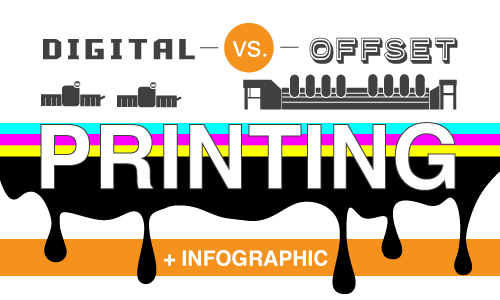Digital Vs. Offset Printing: Which is Right for Your Business?
In the world of printing, there are two main methods to achieve a finished product: digital and offset. For us at Delzer, we live and breathe all things print so it makes sense for us to understand this. But we believe that knowledge is power, and want to extend that empowerment to you as an educated consumer.
The following overview of our two printing services will help you determine whether offset or digital printing will be best for your print projects.
Offset Printing (a.k.a. Lithography)
Lithography/offset printing is a method in which, after a proof is generated and approved, the images and copy in a electronic print file are processed and sent to a plate making device. In this device, a thin, high quality piece of aluminum – the plate – is imaged by a laser. In an offset print job, each color gets its own plate. Once imaged, the plate(s) are taken to press and formed around large rollers in the press color units. As the press runs, the imaged plate, a sheet of paper, and a rubber print “blanket” interact to transfer ink to the sheet – with the inked image going from the plate to the blanket to the print surface.
In other words, lithography could be described as the following equation: larger project quantities + sophisticated process + lots of fancy jargon = high quality results.
Digital Printing
This method prints a digital file directly onto a medium using electrostatic drums and toner. The minimal setup needed for digital printing helps with turnaround time and cost. Digital print also can work with variable data; it can accommodate unique codes, names, addresses, and more.
Advantages of Delzer’s Digital Print Technology
Lower setup costs for short runs and minimum quantities (as little as 1 unit)
Prints exactly how many you need, when you need it
Software capabilities for print-on-demand online storefront ordering
Variable data capabilities (addressing direct mail pieces, coding coupons, etc.)
Wide format and white ink capabilities
Quick turnaround time for same day completion
Wide variety of materials available for print besides paper (wood, leather, cloth, metal, plastic)
Accurate proof samples of the printed piece, showing the exact process as the intended run
Advantages of Delzer’s H-UV Offset Print Technology
Cost effective to run large quantities (the more you print, the less per unit cost)
Allows for larger sheet size
Special effect printing capabilities utilizing varnishes and coatings
Prints special Pantone colors and metallic inks
Provides high quality printing with strong detail and color fidelity
Can print on various paper finishes and plastics of multiple thicknesses
H-UV ink dries fast, which allows us to handle the finishing aspects of the job quicker (cutting, folding, saddle stitching, die cutting – whatever the job requires)
Which Method is Right for You?
Bottom line: If you’re looking for quick turnaround, frequent print jobs, or have constantly changing content, opting for digital print may be best for you. On the other hand, if you’re looking to print large volume static jobs or need specific brand color representation, opting for offset print may be best your best option. Whether you choose digital or offset, your business needs will be met with a high-quality printed product done right through Delzer.




